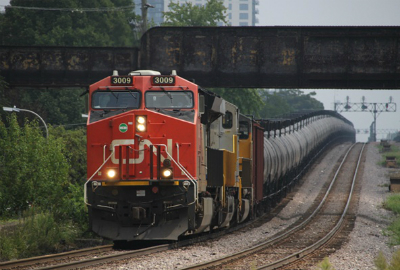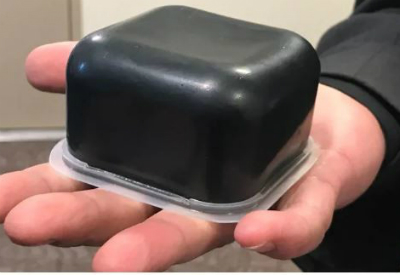By Maureen McCall
The story starts with the Heart Lake First Nations and their relentless pursuit of the value of working together with industry while creating training and employment opportunities for their members. They developed a great model for land use, keeping traditional values and emphasizing low impact on their land while potentially participating in the development of SAGD operations.
Working as Wapahki Energy together with Sproule and CN Rail for almost three years they identified commercial opportunities with small producers who were capable of producing 10,000 to 20,000 boe/d but had no access to pipe and were not getting good netback for their product. The business plan was to get smaller producers access to the world market with a goal of long-term wealth building for the Heart Lake First Nations as well as the producers and partners – a fifty-year project. CN Rail proposed using CanaPux technology which had advantages over shipping raw bitumen. CanaPux is a polymer-mixed solidified bitumen product, that is encased in polymer and is an environmentally secure way of transporting bitumen or heavy crude.
The product has a great safety rating and the reduced environmental impact is multifaceted. Firstly, bitumen is recovered from wells in a heated state so the process involves no extra heat generation for processing. The solidified bitumen pucks are environmentally inert and in the event of an incident, the pellets would simply need to be picked up. CanaPux pellets are not flammable or explosive. Temperatures above 145⁰ C (290⁰ F) are required before CanaPux pellets will burn. In the event of a marine incident the pucks float and are easily recovered. Although CN is a strong supporter of the manufacture of Canapux, they are not a part of a proposed plastic recycling facility that enhances the environmental sustainability of polymerized bitumen or the proposed biomass power plant which is ancillary to the recycling and is another key component.
“We didn’t want to contribute to the world’s plastic problem, we wanted to bring a solution to the world’s plastics problem. We thought of building a massive plastics recycling facility in northern Alberta in the County of Lac La Biche. In building the world’s largest plastics recycling facility, we would be creating two hundred and fifty jobs. We would be taking most of the low density polyethylene from Western Canada to begin with and then accept supply from the rest of Canada as we grow. This is a waste solution for plastics. For every 10,000 barrels of Canapux we produce a day, we would be diverting from the landfill, plastics with the equivalent of 125,000 tonnes of GHG emissions a year.” states Jeff Paquin, CEO Wapahki Energy
Additionally, plastic recovered from the ocean could even be diverted to the project, shipped back from Prince Rupert in the now empty rail cars.
There is another opportunity in biomass powering the plastic recycling facility, which would need about 12 megawatts of power. Instead of using gas to generate power, Wapahki Energy looked at renewable power options and settled on a bio-mass plant to power the recycling facility with a renewable fuel source.
The transportation advantages to CanaPux are substantial. CanaPux are a dry good, capable of being shipped by rail in open gondola cars which are readily available and about 10% of the leasing costs compared to tanker rail car costs. In addition, CanaPux can be shipped in ordinary bulk freighters instead of crude tankers, so they will not be impacted by the Federal moratorium on West Coast tankers. The access to global pricing that this model provides means small producers would have a competitive advantage, It improves the netback by approximately $15 per barrel. There is the potential of increased royalties to the Crown, reduction in GHGs and increased safety as CanaPux float in water, are inert and non-flammable and efficient to clean up in case of an incident on land or in water. CanaPux would be shipped by rail to existing facilities at the Ridley Island Terminal in Prince Rupert. CN research determined the correct dimension of the pucks, so they can be loaded using existing infrastructure that was previously developed for coal and shipped to Asian markets.
As Jeff Paquin elaborates, “In studying South East Asian markets, we realized there was a significant opportunity for non-combustion end use which means a lower carbon footprint. One of the largest manufacturers of waterproof membrane sealants in the world is located in China using bitumen and plastic to create sealants. Faced with curtailed bitumen supply from Venezuela, Asian companies came looking for Canadian bitumen supply and were impressed to be able to obtain both products -a bitumen/recycled plastic blend.
In addition, manufacturers of clothing textiles in Asia are indicating strong demand. Seventy percent of clothing textiles globally are produced using hydrocarbon and plastic. Companies that have been using coal oils which are hazardous can switch to bitumen and recycled plastics. CanaPux is a great solution for transport to manufacturing sites that may be located inland. Asia also has a huge market for polymer blended bitumen to pave roads in the face of Venezuelan curtailment.
There are increased environmental opportunities as the open gondola rail cars return from the west coast to Lac La Biche. In the forests between the west coast to central Alberta, there are environmental issues related to pine beetle damage and the dead wood is a fire protection issue. The trains return from the west coast along highway 16. With an investment in sidings, communities would have an opportunity to harvest the waste wood providing jobs and enabling fire protection measures as part of their long term forest management plans. It’s a dual environmental win that the waste wood would be sent to a bio-mass plant to power the plastic recycling facility with a renewable fuel source. The facility will also be designed to burn construction demolition waste which currently is filling over one third of northern Alberta landfill sites.
Wapahki Energy is partnering to foster business development for the Heart Lake First Nation and their leadership who put environmental action and safety first.
The choice of Wapahki Energy’s name is indicative of their intentions as “Wapahki” is the Cree word for tomorrow.
The time for this vision of tomorrow’s energy is here.
For more information, attend a presentation by James Cairns Vice President of Petroleum and Chemicals at CN Rail discussing the short, medium & long term outlook of crude by rail capacity and CN’s most recent initiatives including CanaPux, March 21st at the Calgary Petroleum Club. Tickets -Members: $50.00 (+GST) Non-Members: $60.00 (+GST)
Go to https://lnkd.in/gq68TEJ To Register.
Sponsored by EnergyNow.ca
Share This:





 CDN NEWS |
CDN NEWS |  US NEWS
US NEWS 






































Borrowing More and More – Federal Budget Brings New Programs and Pains: Margareta Dovgal – Resource Works